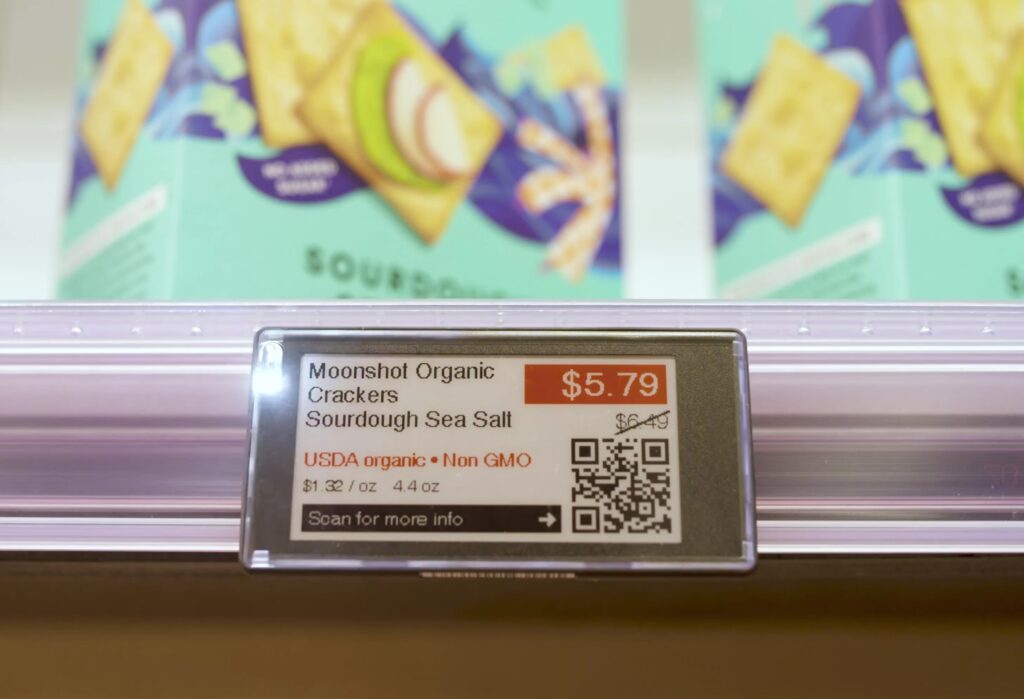
“Blinkies” used to be how couponers would fondly refer to automatic coupon dispensers at the shelf, with a blinking red light at the top. Now the term could end up referring to something else altogether that can help save you money, and time, while grocery shopping.
Instacart says shoppers at several major grocery chains will soon be able to take advantage of its “Carrot Tags” technology, which is currently available only to in-store Instacart shoppers collecting items for online customers. Carrot Tags, named for Instacart’s logo, connect with stores’ digital shelf labels to display a flashing light that will help you find an item on your shopping list.
Instacart introduced Carrot Tags a couple of years ago to help its in-store shoppers fulfill customers’ orders faster and more accurately. Using the Instacart app, these shoppers can access their customers’ shopping list, click on an item they’re not sure where to find to activate the “Pick-to-Light” function, and the shelf label will flash to help them locate it.
“E-commerce shoppers with Pick-to-Light access were able to accurately fulfill orders faster as they spent less time issuing refunds, asking store associates for directions or assistance, or finding replacements,” Instacart explained after an initial in-store test of the technology. “These efficiency gains can help alleviate in-store congestion.”
And now everyday shoppers will be gaining access to the technology. “Looking ahead, pick to light functionality will be available to consumers for the first time on their shopping list,” Instacart has announced. Shoppers using in-store mode on the Instacart app, or an Instacart-powered retailer app, will be able to select an item on their list to activate a flashing signal at the shelf just like Instacart’s own shoppers can.
Instacart says it’s also planning to extend pick to light to its Caper smart shopping carts. This “will enable customers to flash items – whether it’s from their shopping list or an ad or coupon they saw – directly from their cart,” Instacart says.
Carrot Tags are not quite the same as having a digital map of the store that will take you directly to the item you need. You’ll still have to read the aisle markers and make sure you’re at least in the vicinity of what you’re looking for. Carrot Tags are meant to be particularly helpful when there’s a large product assortment or different types of packages that look similar. Many stores’ cereal selection, for example, can fill an entire aisle. Instead of wandering around looking for the brand and size and variety you want, you’ll be able to just click on the item on your digital shopping list, or from your Caper cart, and look for the flashing light directly in front of the exact product you need.
And maybe a digital ad pops up in your app or on your Caper cart screen, offering a special deal or a digital coupon for a product you’re unfamiliar with and don’t know exactly where to find. Click on the ad to activate the flashing light, and you can take advantage of that deal without wasting time searching for it.
Right now, Instacart is working with Schnucks, ALDI, Gelson’s and Hornbacher’s to make Carrot Tags available to Instacart shoppers, and soon to all shoppers.
“Our business model is based on efficiency,” ALDI vice president Scott Patton said in a testimonial statement. Carrot Tags, he said, “are just another way for us to enhance the customer experience while reducing costs and passing along savings to customers.”
They’re also a potential real-world example of how digital shelf tags can prove useful to customers, instead of being something to fear. Many shoppers – and some lawmakers – responded with concern and skepticism after Walmart announced over the summer that it would be introducing digital price tags to thousands of its stores. Walmart said digital tags are more efficient and can be updated in real time. But skeptics wondered whether “updating” price tags meant stores could implement “surge pricing” to raise prices any time there was increased demand. Walmart insists it has no plans to do so.
So a new feature that makes digital shelf tags more useful for shoppers doesn’t mean that surge pricing isn’t possible someday. But it could at least make shoppers more accepting of digitized price tags and take their minds off their suspicions.
Of course, what happens if this pick-to-light technology becomes so popular that everyone uses it, and every aisle is lit up like a Christmas tree with blinking shelf tag lights, and you can’t tell your product apart from someone else’s? For now, that’s not an issue. But if its technology really does catch on to that extent – that’s a problem Instacart would be happy to have to solve.
Image source: Instacart










